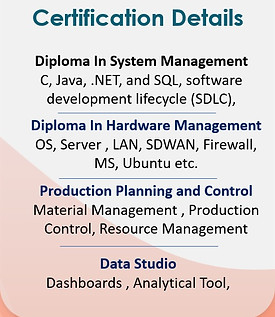
Qualification




Professional Experiance
Professional Experiance
Professional Experiance
ERP Implement Process Cycle

summary covers the major phases—from ERP/Vendor selection to post-go-live support—it's important to note that each stage involved many in-depth tasks and collaborative efforts. This outline is intended to showcase the structured approach and practical involvement across all phases, reflecting real-world execution rather than just theoretical steps.
Centralized Project Hub
centralized SharePoint site to serve as a single access point for project stakeholders. It allows users to view and share critical project information, including documents, timelines, meeting notes, task assignments, status updates, and team details. The platform also enables real-time collaboration by allowing team members to submit updates, share inputs, and stay informed, helping maintain transparency and streamline project communication.
ERP Project Contributions
URD
Before selecting the ERP vendor and application, I collaborated closely with internal users to conduct a detailed fit-gap analysis. This involved understanding current business processes, identifying gaps, and documenting precise user requirements in a User Requirement Document (URD). This thorough preparation ensured that when it came time to evaluate and select vendors, the team had a clear, well-defined framework to choose the solution that best met our needs.
Documentation
I created end-to-end documentation for the ERP implementation, covering vendor and application selection, URD, FRD, UAT plans, training, cost analysis and breakdown, and a detailed communication strategy. It also included key components like escalation matrix, post-go-live support plan, testing checklists, data validation steps, part numbering structure, and regular meeting records. This comprehensive documentation ensured process clarity, vendor alignment, and readiness for the blueprint phase.
Business Flow Chart
Detailed business process flowcharts that clearly map out the key workflows and operations of the organization. These flowcharts provide a comprehensive view of the business, making it easier to communicate processes to vendors during the ERP blueprint phase. Having these ready ensured that the vendor had a clear understanding of our business needs, which streamlined the solution design and customization.
Dashboards
I created interactive dashboards in Google Looker Studio, using data from Google Sheets, Excel files, and SQL databases. These dashboards provided real-time insights and visualizations for better decision-making. The above video showcases examples of some of the Looker Studio dashboards I developed.
Application / APP Developed
Dobby Design Application

I developed Design Dobby, a user-friendly CAD application for textile designers. It allows users to create monograms, patterns, and dobby weaves without needing to worry about machine-specific technical details like color codes or loom settings. The software streamlines the design process by enabling real-time visualization, automatic weave insertion, and easy customization of warp, weft, and color alignment—making it easier for designers to focus purely on creativity and precision.
Barcode - Dispatch Application

Developed an application to prevent box mismatches during the dispatch process. The system ensures that the total number of boxes matches the invoice and verifies that each box is assigned to the correct client. This helps eliminate human error, reduce dispatch mistakes, and improve accuracy in order fulfillment.
I developed a mobile application using the Flutter platform for a manufacturing industry to simplify and improve inventory tracking across multiple storage locations. The app enables users to scan barcodes on storage areas or items to instantly view details such as current stock levels, item locations, and other key inventory information. This solution significantly reduced manual tracking errors and improved inventory visibility across distributed storage points.